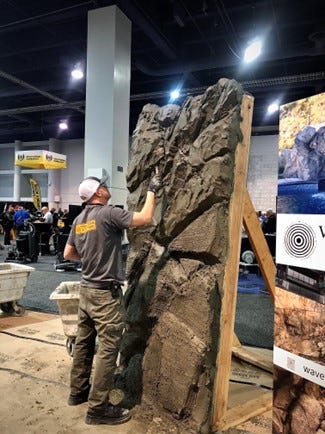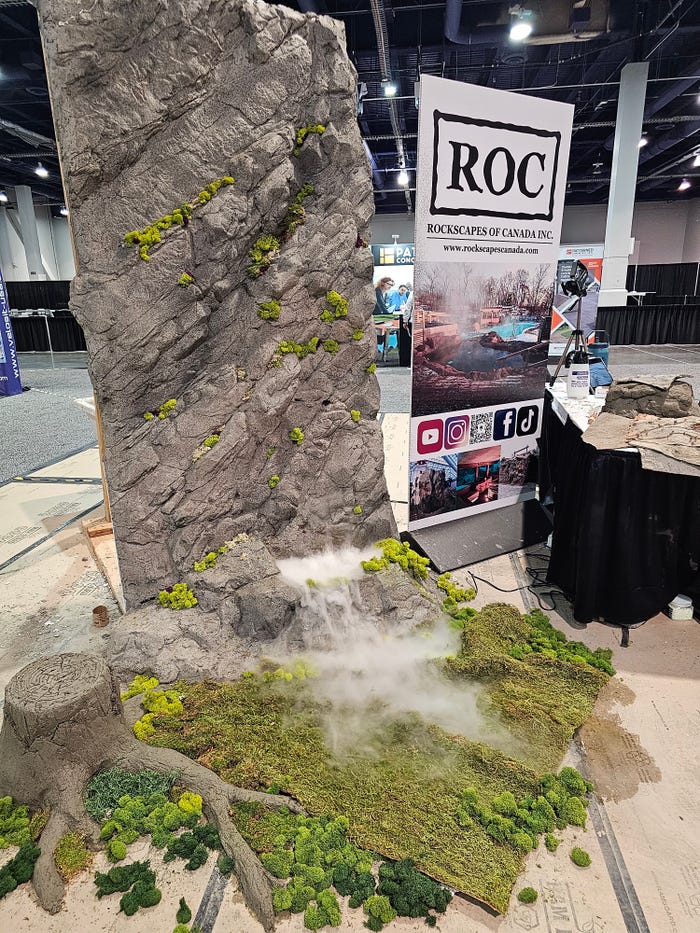Modernizing Artificial Rocks
Artificial Rock Sculpting Live! at World of Concrete 2024 demonstrated how combining artistic talent and modern materials can yield structural artwork.

Historians attribute the initial practice of simulating a natural stone's appearance with a mixture of cementitious materials and aggregates to ancient Roman builders. The engineers used a series of mixtures, opus caementicium, to cast artificial stonework that would match other pieces of natural stone on their iconic structures. Some historians believe their "invention" was due to the necessity to keep working when there was an inventory shortage.
At the 2024 World of Concrete, three artisans demonstrated how efforts to simulate natural rock settings with cementitious materials have evolved into a dynamic concrete construction process. On three small-scale projects, artisans created mockups of this unique aspect of concrete construction.
Often described as a hybrid technique where form meets beauty, artificial rock carving is found on vertical, decorative, and waterfall features that enhance the appearance of common structural elements found in commercial and residential construction.
Pre-modern nature matching
The earliest modern example of artificial rock is Coade stone. Artists used this mixture of fortified clay to mold, cast and harden objects in a process similar to firing brick.
Coade stone's surface simulates marble. From 1769 to 1833, artists used the material to create columns, fireplace mantles and other decorative pieces. Thanks to the material's durability, examples of these elements are still in service on structures in Europe and North America.
A decade later, in 1844, Frederick Ransome filed a patent on another material mixture that simulated natural sandstone. Ransome produced his artificial rock by binding sand and powdered flint in an alkaline solution in an enclosed high-temperature steam boiler. (Interesting historical note: Ransome later developed a patent for the rotary cement kiln, and his son, Ernest L. Ransome, was a significant innovator in the development of reinforced concrete.)
Coade stone and Ransome's patent for concrete stone fell out of favor when their production costs became too high. By 1900, artists and producers made artificial stones with Portland cement-based concrete for projects worldwide.
Artificial rock’s advantages
In 2021, spurred by the demand created by the stay-at-home aspect of the pandemic, the Freedonia Group forecasted that the U.S. demand for hardscaping products would rise 3.3% per year to $3.9 billion in 2025. Its forecast included the use of hardscape, ready-mixed concrete and lumber. While not included in the forecast analysis, the use of artificial rock is probably growing at the same rate. This material offers design professionals and owners an economical and efficient construction technique to transform outdoor spaces such as backyard living areas, pools, and open spaces into nature-themed living experiences. Artisans can simulate the beauty of natural stone in boulders, rock ledges and waterfalls.
Artificial rock construction is often more economical than using natural stone.
Acquiring the perfect natural stone, including quarrying and transporting, can be restrictive even when available. The materials used in artificial rock construction are standard construction materials.
Artisans can craft a wide range of textures and colors that simulate the look of natural stone. The final surface texture can be molded, cast, sculpted over a support structure, panelized or hand manipulated.
Artisans can better control on-site costs and installation time using artificial rock. The contractor can comply with the site design, including structural elements and embedded utilities such as water and lightning.
At World of Concrete 2024, three artisans displayed examples of artificial rock construction. Each artisan created a mini example of their favorite techniques. Let's learn here about each artist and view their completed projects.
Ryan Lee
Matrix Concrete Artisans
At 17 years old, Ryan began working in the rock work industry, learning advanced techniques of building, sculpting and painting from leading rock companies of that time. Growing up on the California coast and regularly visiting family in Kauai, Hawaii, Ryan grew to love nature and studied the movement of water and how it interacts with geological forms. Applying this knowledge, he grew a passion for the unique art of working with his hands to create beautiful spaces through rock work.
Lee says his inspiration has been Philip di Giacomo, who later became a mentor and friend. He shares di Giacomo's principles of understanding nature and social responsibility. Lee centers his art by studying geomorphology.
"To sculpt rocks that mimic Mother Nature, one has to truly understand how a rock's appearance has been formed by both gentle forces such as erosion, wind and water and the dynamic effects created by earthquakes, landslides or flooding," said Lee.
Ryan cofounded Matrix Concrete Artisans with his wife, Vanessa Lee, in 1999. Since then, they lent their artificial rock crafting skills to hundreds of commercial and residential projects. He labeled his display as sedimentary rock.

Wavestone
Trent Hutton
Wavestone Sculpture
Trent Hutton launched his art career by sculpting at various commercial studios in Toronto. He was introduced to artificial rock in Vancouver by working with leading industry contractors at the time.
It wasn't until he visited the crafted landscapes at the Disney properties, did he realize the potential of sculpted concrete. Artificial rock was first created by Bud Washo and Fred Joerger—The Man Who Made Artificial Rocks at Disney. Their sculptured scenes at Disneyland were interesting, but it was the Tree of Life at Walt Disney World that impressed Hutton the most.
"I remember being completely taken with it in my 20s when I first got into this business," said Hutton.
Hutton is a Canadian sculptor known for monolithic concrete works with a focus on natural imagery. His team of artists and contractors hand-sculpt concrete while it is wet to look like realistic rock formations.
With more than 20 years of experience, Wavestone Sculpture is internationally recognized for attention to detail, high realism and artistic excellence.

Rockscapes
Padraic Mangan
Rockscapes of Canada
Padraic Mangan is a second-generation artificial stone artisan. His parents had been artists with a strong interest in creating outdoor features. Their interest in crafting artificial stone began almost three decades ago following a visit to an Italian trade event. They then developed a panelized system with which they simulate actual rock formation's texture with molds.
Over the years, the team has an inventory of molds cast from real rock faces or boulders, with which they can reproduce a wide array of geological formations.
Mangan and his team at Rockscapes of Canada have worked with designers and architects to realize the client's vision by creating a private grotto, cascading waterfalls, rock gardens, streams, spas or retaining walls.
About the Author(s)
You May Also Like




